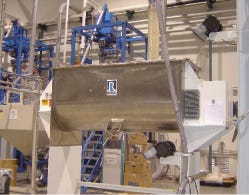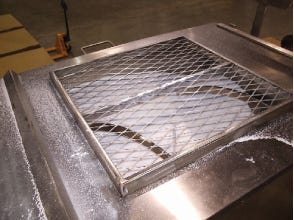Custom Ribbon Blender Helps Craft Perfect Coffee Cup
March 6, 2007
|
On the production floor, Nova Chemicals uses a Ross 42N-36S ribbon blender, which mixes 1000 lb of material per batch. |
A java fan’s quest for the perfect cup of coffee on the way to the office is a science that requires meticulous measurements of top-quality grounds, precise water temperature, and strict brewing times. That same desire for perfection—coupled with somewhat more-complex science—is driving manufacturers of foam cups that hold the coffee from the café to the office. Precision throughout the cup-manufacturing process is crucial to prevent leaks and burned fingertips. Manufacturers must be exact as they blend dry materials, age foam beads in a specified time frame, and set molding temperatures. Today the need for precision is more critical than ever as next-generation cups arrive in the market with striking new features, including high-resolution color graphics on cup walls and much-improved insulating properties.
Nova Chemicals Inc., a Pittsburgh-based company that develops and manufactures plastics and chemicals used in consumer, industrial, and packaging products, is on the leading edge of foam-cup research and development. Just 18 months ago, the company introduced IMx, a new patent-pending technology that has markedly improved the quality and insulation of expandable polystyrene (EPS) cups, sometimes referred to as “fat white cups” in the industry.
Greener Foam Cups—A Smart Marketing Tool
Traditional EPS foam cups, which are 95% air and just 5% polystyrene, have a soft, bumpy surface. In the conventional EPS process, tiny polystyrene beads are expanded and then molded into the sturdy but somewhat squishy foam cups regularly stacked alongside coffee urns.
At Nova Chemicals, EPS cups made using IMx technology are more environmentally friendly than traditional foam or paper cups. Because IMx technology creates sturdier, smoother, and less “puffy” cups that keep liquids hot or cold longer, there is no need for a wasteful paper sleeve or “double cupping” to protect fingers from hot temperatures. The result: less garbage in landfills.
Central to IMx technology is the equipment that molds cups. For the first time, a single machine can now mold a cup while simultaneously incorporating a colorful, detailed graphic label featuring a photo, drawing, or company logo. Before IMx, adding graphics to a foam cup required a separate step that often lengthened production time and increased costs. Today, with companies searching for innovative ways to brand products and services, IMx technology provides a new option: foam cups with a fresh canvas ready for color.
“IMx technology makes it possible to mold and print stylish and functional EPS cups in a single step,” remarks Tony Torres, vice president of Styrenics Business Development at Nova Chemicals.
Mixing Key to Precision of IMx Technology
Crucial in the initial manufacturing step, precision is the hallmark of the IMx process. It is achieved by evenly mixing minuscule white polystyrene beads with a fine white powder lubricant. The lubricant, zinc stearate, plays an essential role throughout the cup-making process. During the first step, a small amount of lubricant is layered uniformly on all the beads. The amount used is enough to remain on the beads throughout the manufacturing process but not too much so that the beads will not fuse together properly when heated.
When work began five years ago to develop IMx technology, Nova Chemicals researchers turned to Charles Ross & Son Co. (Hauppauge, NY) to provide a custom ribbon blender to carefully mix and coat tiny polystyrene beads with the powder lubricant.
“It’s crucial to have a uniform coating on the beads,” says Dennis Piispanen, applications technologist at Nova Chemicals who, after 39 years at the company, is considered the cup expert. “If lubricant isn’t evenly distributed on all beads, cups will stick in the mold or develop leaks when filled with a drink. We know from experience that Ross mixers are very good at uniform mixing.”
Nova Chemicals owns three Ross ribbon blenders: two small models for the laboratory and a 9½-ft-long 42N-36S horizontal ribbon blender that mixes 1000-lb batches of beads and lubricant powder in the company’s production plant. The production mixer stands on 8-ft-tall support legs that allow carts—or gaylords—to be positioned beneath the blender for discharge of the coated beads when blending is finished. The units are designed to blend dry or liquid ingredients quickly. The double-ribbon design mixes ingredients simultaneously and evenly in three axes: side to side, up and down, and front to back.
“I’d never worked with a ribbon blender before,” notes John Madish, IMx manufacturing leader, who oversees the operation of the Ross blender in the production plant. “But compared with other blenders, it’s far superior. When you look under a microscope at beads that have been in a Ross mixer, there’s consistent lubricant coating on each bead. It’s exactly what we want.”
|
Close-up view of polystyrene beads mixing with lubricant in the Ross 42N-36S ribbon blender |
Ribbon-to-Trough Tolerance
For the IMx technology, Piispanen and his lab colleagues wanted a mixer with near-zero clearance between the ribbons that blend the ingredients and the U-shaped stainless-steel trough in which the ingredients are mixed. The polystyrene beads placed in the Ross trough are just 1/100 of an inch in diameter, and the zinc-stearate lubricant is even smaller. “We’re dealing with incredibly small particles,” Piispanen observes. “If there’s too much space between the ribbon and trough, then material gets hung up on the trough sides. We want lubricant on the beads, not the trough. Fortunately, we don’t have any issues of this kind with the Ross blender.”
Madish reiterates the importance of close tolerance. “If zinc stearate builds up, it can pack in, get really hard, break off in chunks, and clog the fill tips in the cup mold. Then we have to shut down machinery to clean it, which means lost production time. “Ross mixers stay functioning,” he adds. During routine cleanings, the blenders’ meticulous design—polished stainless-steel walls, internal welds ground smooth, and no crevices or pits—makes them easier and faster to scrub than other mixers.
Finding a Scaled-Down Blender
“When we started IMx trials,” says Piispansen, “we wanted a very scaled-down version of a blender to use in the lab. Something that held just ¼ cu ft—about 10 lb of material. But there was nothing that small available on the market.” In comparison, the commercial-grade Ross blender used by Nova Chemicals is nearly 10 ft long and holds 36 cu ft of material weighing 1000 lb.
Piispanen called the Ross regional sales manager who had worked with Nova Chemicals for years. “At the time, the smallest blender Ross made was 1 cu ft in size. I told Jim what we needed and he said, ‘No problem.’ We got a quote soon after for Ross to custom manufacture a single-speed lab ribbon blender for us.”
Nova Chemicals policy requires employees to receive quotes from multiple vendors. “I called other manufacturers, but couldn’t get anyone else to quote us a lab blender,” Piispanen notes. “All I received were letters saying, ‘Call us when you need a full-size blender; we can help you then.’ Ross was there to do anything for us. They came back with drawings for a ¼-cu-ft single-speed mixer we used in trials to determine the amount of lubricant needed in the IMx process.”
The lab team asked Ross for a mixer with special close tolerance between the ribbon and trough. They also wanted a mixer designed so that no material would stick to the sides or edges. “We need to follow FDA rules for sanitary production,” remarks Piispanen. “We asked Ross for special sanitary packing on the agitator shaft. They listened and were very quick to respond to our requests.”
Madish adds, “Ross was willing to build what we wanted at a reasonable price. They’re very amenable to making any change you want, even after delivery. That’s why we continue to work with them.”
IMx Production Under Way
On the Nova Chemicals production floor, the 36-cu-ft Ross ribbon blender uniformly coats each bead with lubricant during a 30-minute mixing process. Coated beads are then carefully moved from the blender to another container where hot steam expands the beads to three times their original size. “The lubricant keeps the beads from sticking together during this process,” Piispanen observes. “Even after expansion, lubricant remains on each bead because it’s needed later in the process.”
The puffed-up beads then sit for 24 hours to dry and stabilize. Next, the dry, enlarged beads are injected into the IMx cup mold. “The beads need a little help moving through the fill-tip when injected into the mold,” Piispanen says. “Lubricant added earlier in the Ross blender serves as a flow aid.”
Finally, after the cup is molded and vivid graphics added, the lubricant helps release the cup from the mold, just like cooking spray helps a cake fall out of its pan. “It’s about being precise,” Piispanen adds. “Cup making is all about uniformity. The first step, where the Ross blender coats lubricant on the polystyrene beads, is critical to ensuring a smooth, continual work flow during the entire cup-making process.”
For more information, contact Charles Ross & Son Co. at 800-243-7677 or www.mixers.com. Nova Chemicals Inc. can be reached at 412-490-4774 or www.novachem.com.
You May Also Like




